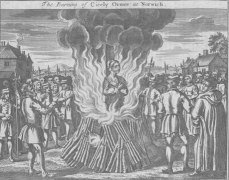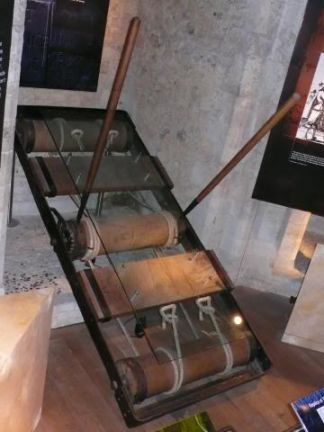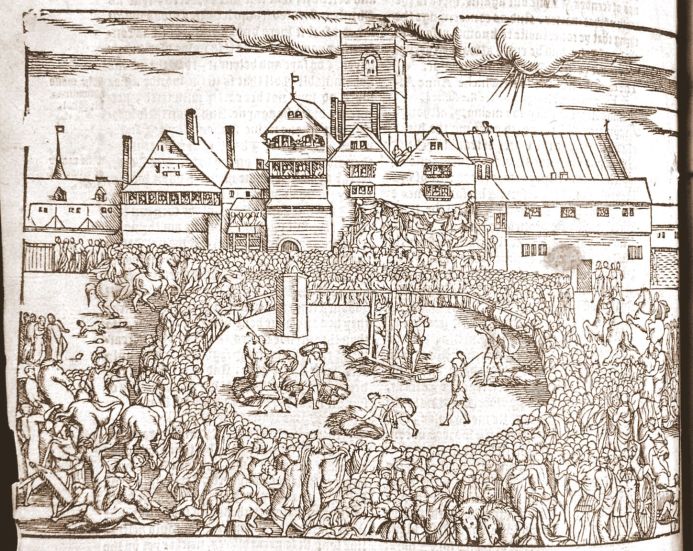Anne Askew - Historical Profile
INTERESTING FACTS:
Anne Askew's writing 'Examinations' defies the constraints of gender and hierarchy, and attempts to expose patriarchal insecurity surrounding female involvement in traditionally male religious subjects: "They said to me there that I was a heretic, and condemned by the law if I would stand in my opinion. I answered that I was no heretic, neither yet deserved I any death by the law of God. But as concerning the faith which I uttered and wrote to the council, I would not, I said, deny it, because I knew it true. Then they would needs know if I would deny the sacrament to be Christ's body and blood. I said, "Yea, for the same son of God that was born of the Virgin Mary, is now glorious in heaven, and will come again from thence at the latter day, like as he went up (Acts 1). And as for that ye call your God, is but a piece of bread. For a more proof of thereof (mark it when ye list) yet it lie in the box but three months, and it will be mould and so turn to nothing that is good. Whereupon I am persuaded that it cannot be good." The Death of Anne Askew
| Act of the Six Articles 1539 Extract from Foxes Monuments, Ed Rev Geo Townsend (1846) Vol 5 p 262). In this parliament, synod, or convocation, certain articles, matters, and questions, touching religion, were decreed by certain prelates, to the number especially of six, commonly called ‘The Six Articles’ (or, ‘The Whip with Six Strings’), to be had and received among the king’s subjects, on pretence of unity. But what unity thereof followed, the groaning hearts of a great number and also the cruel death of divers, both in the days of King Henry, and of Queen Mary, can so well declare as I pray God never the like be felt hereafter. The doctrine of these wicked articles in the bloody Act contained, although it be worthy of no memory amongst Christian men, but rather deserveth to be buried in perpetual oblivion, yet, for that the office of history compelleth us thereunto, for the more light of posterity to come, faithfully and truly to comprise things done in the church, as well one as another, this shall be briefly to recapitulate the sum and effect of the aforesaid six articles, in order as they were given out, and hereunder do follow. The First Article. The first article in this present parliament accorded and agreed upon, was this That in the most blessed sacrament of the altar by the strength and efficacy of Christs mighty word (it being spoken by the priest), is present really, under the form of bread and wine, the natural body and blood of our Saviour Jesus Christ, conceived of the Virgin Mary; and that after the consecration there remaineth no substance of bread or wine, or any other substance, but the substance of Christ, God and man. The Second Article. That the communion in both kinds is not necessary ‘ad salutern,’ by the law or God, to all persons: and that it is to be believed, and not doubted of but that in the flesh, under form of bread, is the very blood, and with the blood, under form of wine, is the very flesh as well apart, as they were both together. The Third Article. That priests, after the order of priesthood received as before, may not marry by the law of God. The Fourth Article. That vows of chastity or widowhood, by man or woman made to God advisedly ought to be observed by the law of God; and that it exempteth them from other liberties of Christian people, which, without that, they might enjoy. The Fifth Article. That it is meet and necessary, that private masses be continued and admitted in this English church and congregation; as whereby good Christian people, ordering themselves accordingly, do receive both godly and goodly consolation. and benefits2 and it is agreeable also to God’s law. The Sixth Article, That auricular confession is expedient and necessary to be retained and continued, used and frequented, in the church of God. 1. Advisedly, that is made above the age of one and twenty years, priests only excepted. 2. By this, is meant, the helping of souls in purgatory. The Act provided that all who denied the first should be burned as heretics. Those who persistently refused assent to the others should be hanged as felons. One immediate effect was that many zealous Reformers left the country and went to Germany and Switzerland where they joined with particularly the Zwinglian school. In England it led to Latimer resigning the bishopric of Worcester and Shaxton that of Salisbury. It also compelled Thomas Cranmer to send his German (Lutheran) wife back to relatives and was only himself saved by the influence of the king. Although not enforced with relentless severity, the Act nevertheless resulted in over five hundred people being imprisoned. It was under this Act that Anne Askew was prosecuted and burnt. |
“The rack” in the basement of the garden tower aka the bloody tower in the Tower of London | "The rack was worked by a wheel at the head, and, in the first stage, that was turned and held taught by hand. For more reluctant prisoners, a ratchet could be applied, which stopped the rack from going slack between turns. Wriothesley [[[Risley]]] and Rich put the ratchet on, and went to work stretching Anne. Apart from the pain of stretching muscles and cracking joints, the rack constricted the wrists and ankles, causing blood to flow from the finger nails. Anne's cries could be heard in the garden next to the White Tower where the Lieutenant's wife and daughter were walking. So piteous were the cries that they turned indoors and shut the windows. Anne gave no names, and her ordeal was finally ended when the Lieutenant ordered her to be returned to her cell." [Wikipedia] |
| LITERATURE: Non-fiction
| SOURCES:
|


